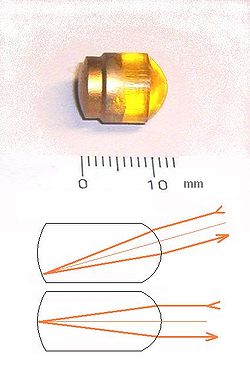Cat's eye
Cat eyes , engl. cat's eyes are small, cylindrical glass bodies approx. 10 to 20 mm in diameter with a curved, mirrored back and a curved front. Similar to the eyes of a cat or other nocturnal animals, they reflect the light back in the direction from which it comes, largely regardless of their orientation. Cat eyes belong to the group of retroreflectors .
In German, flat rear reflectors or retroreflectors are often colloquially referred to as cat's eyes based on the principle of triple mirror arrays .
Real, that is, rotationally symmetrical cat eyes go back to an invention of the British Percy Shaw in 1934 (patents GB 436 290 A and 457 536).
Layout and function

A cat's eye essentially consists of a rotationally symmetrical glass body in the form of a cylinder, which has spherically curved end surfaces at both ends. It resembles the middle part of an eye with a spherical cornea on the front and a spherical retina on the back. The back (“retina”) of the cat's eye is mirrored and lies in the focal point of the front curved surface, which forms a converging lens . The front and back have the same center of curvature , so that the incident light is always reflected back in the direction of incidence, even if the light is incident at an angle (top sketch).
Because of the spherical aberration , not every light beam is reflected exactly in the direction of incidence. The further a ray deviates from the optical axis, the greater this deviation. It is only through this slight deviation that the cat's eye (or any other retro-reflector) can fulfill its purpose in that the reflected light reaches the observer's eye. If the light were to be reflected back exactly in the direction of incidence without deviation, then it would not reach the observer, but only back into the light source.
There is no need for a large “retina” area or a “viewing angle” as large as with a real eye, so the edge areas that are missing for the shape of a real eye can be omitted.
Mode of action and areas of application
Natural and artificial cat eyes appear much brighter when illuminated from the direction of the observer than diffuse reflecting bodies. People who look at such a scene from a different angle will not be able to see any particular luminous effect of the cat's eye, since the light is only reflected in the direction of incidence. For an observer without their own light source, a cat's eye does not appear brighter than the surroundings.
Rotationally symmetrical "cat's eyes" made of glass are still used today in raised road markings and construction site barriers as well as in motorway emergency telephones.
Only very old bicycles sometimes still have "real" cat eyes as reflectors.
See also
literature
- Michael Gressmann, Franz Beck, Rüdiger Bellersheim: specialist knowledge of bicycle technology. 1st edition, Verlag Europa Lehrmittel, Haan-Gruiten, 2006, ISBN 3-8085-2291-7
- Fritz Winkler, Siegfried Rauch: Bicycle technology repair, construction, production. 10th edition, BVA Bielefelder Verlagsanstalt GmbH & Co. KG, Bielefeld, 1999, ISBN 3-87073-131-1
Individual evidence
- ^ Cats eye in the middle of the road in Ireland to help with vision at night at a low angle. Alamy , 2007, accessed August 5, 2020 .
